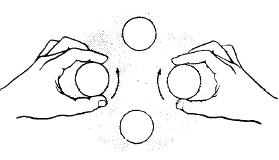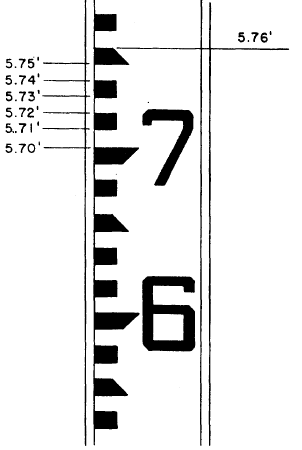|
Leveling the Engineers Level As a rodman, you must concentrate on keeping
your rod perfectly plumb. Readings on a
rod that is out of plumb are inaccurate. Similarly,
as a levelman, you must constantly bear
in mind that the line of sight through the
telescope must be perfectly level in every direction
or every reading you make with the instrument
will be inaccurate. After you initially place
the instrument, level it carefully as follows: Train
the telescope in line with a pair of level screws
and manipulate the level screws by turning them
in opposite directions, as shown in figure 14-7, until
the bubble in the level vial is in the exact center.
It is helpful to know that the bubble in the level
vial will move in the direction that your left thumb
moves. To put this another way: When you turn
the left-hand screw clockwise, the bubble moves
to your left; when you turn the left-hand screw
counterclockwise, it moves to your right. When
the bubble is centered with the telescope over
one pair of screws, train the telescope over the
other pair and repeat the process. As a check, swing
the telescope over each pair of screws in all
four possible positions to make sure the bubble
is centered in each position.
Making Direct Readings
The instrumentman makes a direct rod reading as
viewed directly on the graduation of the rod (self-reading)
that is in line with the horizontal

Figure 14-7.-Manipulating level screws.

Figure 14-8.-Showing a direct reading of 5.76 ft on a Philadelphia
rod.
cross hair. A rod other than an architects rod is usually
graduated in feet subdivided to the nearest 0.01
ft; therefore, direct readings are possible only to
the nearest 0.01 ft.
Figure 14-8 shows a direct reading of 5.76 ft on
a Philadelphia rod. You can see that each black graduation
and each white, interval represents 0.01 ft.
You can see also that the black figure 7 is the only
numeral of the reading 5.76 ft that appears in
the view. The red numeral 5 would not be visible
through the telescope unless the sight distance
was quite far away. For this reason, you would
signal the rodman to "raise for red," as described
in the previous chapter.
To make sure you relate the reading for tenths and
hundredths to the correct whole-foot red numeral,
it is best to make a direct reading as follows:
When the horizontal cross hair and the rod
are brought into clear focus, first determine the
number of hundredths. Then, read the next lower
black figure for the tenths. Finally, signal for
a "raise for red," and note the number of whole
feet.
|







